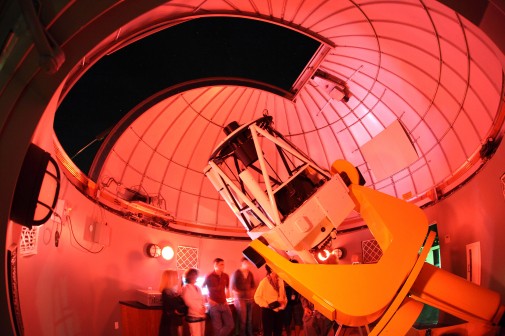Viewing of Stars to Highlight Celestial Treats
By
Westmont

Westmont’s powerful Keck Telescope will be the focus of attention for Central Coast stargazers Friday, Oct. 21, beginning at about 7 p.m. The observatory opens its doors to the public every third Friday of the month in conjunction with the Santa Barbara Astronomical Unit, whose members bring their own telescopes to Westmont for the public to gaze through. The viewing lasts for several hours. In case of inclement weather, please call the Telescope Viewing Hotline at (805) 565-6272 and check the Westmont website to see if the viewing has been cancelled.
Westmont physics instructor Thomas Whittemore says he hopes to focus the Keck Telescope on one of the finest binary star systems in the autumn sky, Eta Cassiopeiae. “This two-star system exhibits a spectacular color contrast with the primary star — a G type star very similar to our Sun — being yellow while its smaller companion is reddish,” he says. The stars lie about 19 light-years from Earth and take nearly 500 years to circuit one another. “In my 8-inch reflector at 60X, I see the dimmer companion glowing with a ghostly amber hue,” he says. “I think that the public will really enjoy this pre-Halloween piece of eye candy.”
The Globular Cluster, M15, in Pegasus may also impress stargazers. M15 is located about 40,000 light-years from us, containing a few hundred thousand stars in a ball about 125 light-years in diameter. “Larger telescopes have found that M15 is a source of X-rays, which implies that one of its members is a neutron star, or possibly a black hole,” he says.
Jupiter will rise after 6:30 p.m., but will not be in a good viewing position until after 9:30 p.m. “Even then, it’ll only be about 30 degrees above the horizon,” Whittemore says. “But hopefully at least one of Jupiter’s four Galilean moons will be in view — Io, Callisto and Ganymede on one side of the Gas Giant and Europa on the other.”
Westmont students and faculty use the 24-inch reflector telescope to conduct astronomical research. The Keck Telescope is housed in the observatory between Russell Carr Field and the track and field/soccer complex. Free parking is available near the baseball field.
Filed under
Campus Events, Campus News, Press Releases